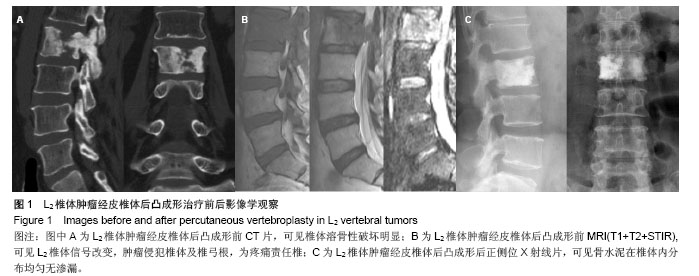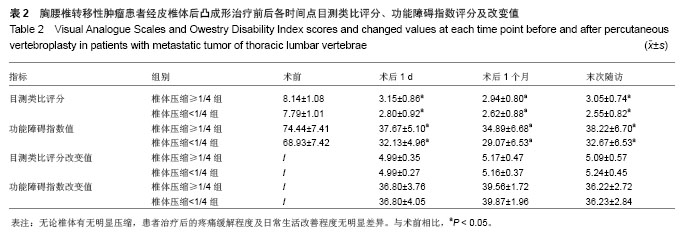| [1]姜亮,刘忠军,党耕町,等.CT引导下经皮穿刺脊椎活检在脊柱转移癌诊断中的作用[J].中国脊柱脊髓杂志,2003,13(2):82-84.
[2]Deutsch H, Boco T, Lobel J.Minimally invasive transpedicular vertebrectomy for metastatic disease to the thoracic spine. Spinal Disord Tech.2008;21:101-105.
[3]Wetzel FF,Phillips FM.Management of metastatic disease of the spine.Orthop Clin North Am.2000;31(4):611-621.
[4]Cooper C,Atkinson EJ,Fallon WM,et al.Incidence of clinically diagnosed vertebral fractures: a population-based study in Rochester,Minnesota,1985-1989.J Bone Miner Res.1992; 7(2):221-227.
[5]Lieberman IH,Dudeney S,Reinhardt MK,et al.Initial outcome and efficacy of “kyphoplasty” in the treatment of painful osteoporotic vertebral compression fractures.Spine Phila Pa.2001;26(14):1631-1638.
[6]Hadjipavlou AG,Tzermiadianos MN,Katonis PG,et al. Percutaneous vertebroplasty and balloon kyphoplasty for the treatment of osteoporotic vertebral compression fractures and osteolytic tumours.J Bone Joint Surg Br. 2005;87: 1595-1604.
[7]Pflugmacher R, Kandziora F, Schroeder RJ, et al. Percutaneous balloon kyphoplasty in the treatment of pathological vertebral body fracture and deformity in multiple myeloma: a one-year follow-up.Acta Radiol.2006; 47: 369-376.
[8]Fourney DR, Schomer DF, Nader R, et al. Percutaneous vertebroplasty and kyphoplasty for painful vertebral body fractures in cancer patients. Neurosurg. 2003;98:21-30.
[9]Qian Z, Sun Z, H Yang, et al. Kyphoplasty for the treatment of malignant vertebral compression fractures caused by metastases. J Clin Neurosci. 2011;18(6):763-767.
[10]Cotton A,Boutry N,Comet B,et al.Percutaneous vertebroplasty: state of the art. Radiographics. 1998;18(2): 311-320; discussion 320-323.
[11]San Millan Ruz D, Burkhardt K, Jean B, et al. Pathology findings with aerylic implants.Bone.1999;25(Supp1):85-90.
[12]Barr JD, Barr MS, Lemley TJ, et al. Percutaneous vertebroplasty for pain relief and spinal stabilization. Spine. 2000;25(8):923-928.
[13]Mathis JM,Ortiz AO,Zoarski GH.Vertebroplasty versus kyphoplasty:a comparison and contrast.AJ NR Am J Neuroradiol. 2004;25(5):840-845.
[14]徐宝山,胡永成.经皮椎体后凸成形术的临床应用进展[J].中华骨科杂志,2003,23(5):271-274.
[15]Nussbaum DA,Gailloud P,Murphy K.A review of complications associated with vertebroplasty and kyphoplasty as reported to the Fod and Drug Administration medical device related web site. Vase Interv Radial.2004;15:1185-1192.
[16]Steinmann J,Tingey CT,Cruz G,et al.Biomechanical comparison of unipedicular versus bipedicular kyphoplasty. Spine.2005;30(2):201-205.
[17]Gangi A,Guth S,Imbert JP,et al.Pereutaneons vertebroplasty: indications,technique,and results. Radiographics.2003;23(11): 10.
[18]Akio H,Toshio M,Yuji N,et al.Increase in vertebral body height after vertebroplasty.AJNR AmJ Neuroradiol. 2003;23(10): 185-189.
[19]Hulme PA,Krebs J,Ferguson SJ,et al.Vertebroplasty and kyphoplasty:a systematic review of 69 clinical studies,Spine (Phila Pa 1 976).2006;31(17):1983-2001
[20]Lee MJ,Dumonski M,Cahill P,et al.Percutaneous treatment of vertebral compression fractures:a meta-analysis of complications.Spine(Phila Pa 1 976).2009;34(11):1228-1232.
[21]Heran MK,Legiehn GM,Munk PL.Current concepts and techniques in percutaneous vertebroplasty.Orthhop Clin North Am.2006;37(3):409-434. |


